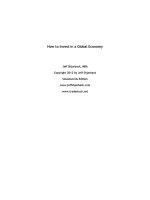Managing in a global economy by john marthinsen babson MBA chapter 11
Bạn đang xem bản rút gọn của tài liệu. Xem và tải ngay bản đầy đủ của tài liệu tại đây (10.59 MB, 30 trang )
CHAPTER 11
Fiscal Policy and Automatic Stabilizers: What Managers Need to Know
Copyright© 2008 South-Western, a part of Cengage Learning. All rights
reserved.
Exhibit 11-1
Categories of U.S. Government Taxation, 2006
Source: U.S. Economic Report of the President, 2006, />p. 377 (accessed September 17, 2006).
Copyright© 2008 South-Western, a part of Cengage Learning. All rights
reserved.
Exhibit 11-2
Categories of U.S. Government Spending, 2006
Source: U.S. Economic Report of the President, 2005, />p. 377 (accessed September 17, 2006).
Copyright© 2008 South-Western, a part of Cengage Learning. All rights
reserved.
Exhibit 11-3
Types and Maturities of Government Securities
Copyright© 2008 South-Western, a part of Cengage Learning. All rights
reserved.
Exhibit 11-4
Owners of U.S. Government Debt, 1981–2006
Source: Federal Reserve Bank of St. Louis, Economic Data—FRED II, />(accessed September 17, 2006).
Copyright© 2008 South-Western, a part of Cengage Learning. All rights
reserved.
Exhibit 11-5
Effects of Government Borrowing in the Real Loanable
Funds Market
Copyright© 2008 South-Western, a part of Cengage Learning. All rights
reserved.
Exhibit M11-1
Crowding Out with Perfectly Elastic, Perfectly Inelastic,
and an Upward-Sloping Supply of Real Loanable Funds
Copyright© 2008 South-Western, a part of Cengage Learning. All rights
reserved.
Exhibit 11-6
Effects of Increased Government Borrowing in the Real
Goods Market
Copyright© 2008 South-Western, a part of Cengage Learning. All rights
reserved.
Exhibit M11-2
Effects of Government Borrowing in the Real
Loanable Funds Market
Copyright© 2008 South-Western, a part of Cengage Learning. All rights
reserved.
Exhibit 11-7
Budget Surpluses Increase the Supply of Real
Loanable Funds
Copyright© 2008 South-Western, a part of Cengage Learning. All rights
reserved.
Exhibit 11-8
U.S. Government Deficits and Surpluses, 1970–2005
Source: The White House, Office of Management and Budget, 2005, from Federal Reserve Bank of St. Louis,
Economic Data—FRED II, (accessed September 17, 2006).
Copyright© 2008 South-Western, a part of Cengage Learning. All rights
reserved.
Exhibit 11-9
Actual Deficit Active Deficit + Passive Deficit
Copyright© 2008 South-Western, a part of Cengage Learning. All rights
reserved.
Exhibit 11-10
Neutral Fiscal Policy: Active Deficit = 0
Copyright© 2008 South-Western, a part of Cengage Learning. All rights
reserved.
Exhibit M11-3
Assumptions for Calculating the Active and
Passive Deficits
Copyright© 2008 South-Western, a part of Cengage Learning. All rights
reserved.
Exhibit M11-4
Actual Deficit = Active Deficit + Passive Deficit
Copyright© 2008 South-Western, a part of Cengage Learning. All rights
reserved.
Exhibit M11-5
Neutral Fiscal Policy: Active Deficit = 0
Copyright© 2008 South-Western, a part of Cengage Learning. All rights
reserved.
Exhibit 11-11
Expansionary Fiscal Policy: Active Deficit = $30 Billion
Copyright© 2008 South-Western, a part of Cengage Learning. All rights
reserved.
Exhibit 11-12
Contractionary Fiscal Policy: Active Surplus
Copyright© 2008 South-Western, a part of Cengage Learning. All rights
reserved.
Exhibit 11-13
Lags in Fiscal Policy
Copyright© 2008 South-Western, a part of Cengage Learning. All rights
reserved.
Exhibit 11-14
Total U.S. Public Debt, 1966–2006
Source: Federal Reserve Bank of St. Louis, Economic Data—FRED, />(accessed September 17, 2006).
Copyright© 2008 South-Western, a part of Cengage Learning. All rights
reserved.
Exhibit 11-15
U.S. Real Per Capita Government Debt, 1966–2006
Source: Federal Reserve Bank of St. Louis, Economic Data—FRED, />(accessed September 17, 2006).
Copyright© 2008 South-Western, a part of Cengage Learning. All rights
reserved.
Exhibit 11-16
Changes in a Government’s Balance Sheet
Assets Liabilities + Stockholders’ Equity
Copyright© 2008 South-Western, a part of Cengage Learning. All rights
reserved.
Exhibit 11-17
U.S. Government Debt-to-GDP Ratio, 1966–2006
Source: Federal Reserve Bank of St. Louis, Economic Data—FRED, />(accessed September 17, 2006).
Copyright© 2008 South-Western, a part of Cengage Learning. All rights
reserved.
Exhibit 11-18
International Comparison: Government Debt-to-GDP
Ratios of Developed Nations for 2006
Source: OECD, Annex Table 32, ‘‘General Government Gross Liabilities: Percent of Nominal GDP,’’ http://
www.oecd.org/dataoecd/5/51/2483816.xls (accessed September 17, 2006).
Copyright© 2008 South-Western, a part of Cengage Learning. All rights
reserved.
Exhibit 11-19
A Nation’s Monetary Base Changes When Our
Imaginary Horizontal Line Is Crossed
Copyright© 2008 South-Western, a part of Cengage Learning. All rights
reserved.









